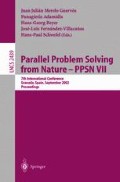Abstract
In this paper, we study an evolutionary algorithm employed to design and optimize a local control of chaos. In particular, we use a multi—objective fitness function, which consists of the objective function to be optimized and an auxiliary quantity applied as an additional driving force for the algorithm. Numerical results are presented illustrating the proposed scheme and showing the influence of employing such a multi—objective fitness function on convergence of the algorithm.
Access this chapter
Tax calculation will be finalised at checkout
Purchases are for personal use only
Preview
Unable to display preview. Download preview PDF.
References
Bäck, T.: Evolutionary Algorithms in Theory and Practice: Evolution Strategies, Evolutionary Programming, Genetic Algorithms. Oxford University Press, New York (1996)
Baier, G., Klein, M.: Maximum hyperchaos in generalized Hénon maps. Phys. Lett. A151 (1990) 281–284
Fletcher, R.: Practical Methods of Optimization. John Wiley, Chichester (1987)
Goldberg, D.E.: Genetic Algorithms in Search, Optimization, and Machine Learning. Addision-Wesley, Reading MA (1989)
Kailath, T.: Linear Systems. Prentice-Hall, Englewood Cliffs NJ (1980)
Lin, C.T., Jou, C.P.: Controlling chaos by GA-based reinforcement learning neural network. IEEE Trans. Neural Networks 10 (1999) 846–859
Marin, J., Solé, R.V.: Controlling chaos in unidimensional maps using macroevolutionary algorithms. Phys. Rev. E65 (2002) 026207/1-6
Michalewicz, Z.: Genetic Algorithms + Data Structures = Evolution Programs. 3rd edn. Springer-Verlag, Berlin Heidelberg New York (1996)
Ott, E.: Chaos in Dynamical Systems. Cambridge University Press, Cambridge (1993)
Packard, H.N.: A genetic learning algorithm for the analysis of complex data. Complex Systems 4 (1990) 543–572
Paterakis, E., Petridis, V., Kehagias, A.: Genetic algorithm in parameter estimation of nonlinear dynamical systems. In: Eiben, A.E., Bäck, T., Schoenauer, M., Schwefel, H.P. (eds.): Parallel Problem Solving from Nature-PPSN V. Springer-Verlag, Berlin Heidelberg New York (1998) 1008–1017
Richter, H., Reinschke, K.J.: Local control of chaotic systems: A Lyapunov approach. Int. J. Bifurcation and Chaos 8 (1998) 1565–1573
Richter, H., Reinschke, K.J.: Optimization of local control of chaos by an evolutionary algorithms. Physica D144 (2000) 309–334
Rodriguez-Vázquez, K., Fleming, P.J.: Multi-objective genetic programming for dynamic chaotic systems modelling. In: Congress on Evolutionary Computation, CEC’99, Washington, D.C., USA, (1999) 22–28
Szpiro, G.G.: Forecasting chaotic time series with genetic algorithms. Phys. Rev. E55 (1997) 2557–2568
Weeks, E.R., Burgess, J.M.: Evolving artificial neural networks to control chaotic systems. Phys. Rev. E56 (1997) 1531–1540
Yadavalli, V.K, Dahulee, R.K., Tambe, S.S., Kulkarni, B.D.: Obtaining functional form of chaotic time series evolution using genetic algorithm. Chaos 9 (1999) 789–794
Author information
Authors and Affiliations
Editor information
Editors and Affiliations
Rights and permissions
Copyright information
© 2002 Springer-Verlag Berlin Heidelberg
About this paper
Cite this paper
Richter, H. (2002). An Evolutionary Algorithm for Controlling Chaos: The Use of Multi—objective Fitness Functions. In: Guervós, J.J.M., Adamidis, P., Beyer, HG., Schwefel, HP., Fernández-Villacañas, JL. (eds) Parallel Problem Solving from Nature — PPSN VII. PPSN 2002. Lecture Notes in Computer Science, vol 2439. Springer, Berlin, Heidelberg. https://doi.org/10.1007/3-540-45712-7_30
Download citation
DOI: https://doi.org/10.1007/3-540-45712-7_30
Published:
Publisher Name: Springer, Berlin, Heidelberg
Print ISBN: 978-3-540-44139-7
Online ISBN: 978-3-540-45712-1
eBook Packages: Springer Book Archive

